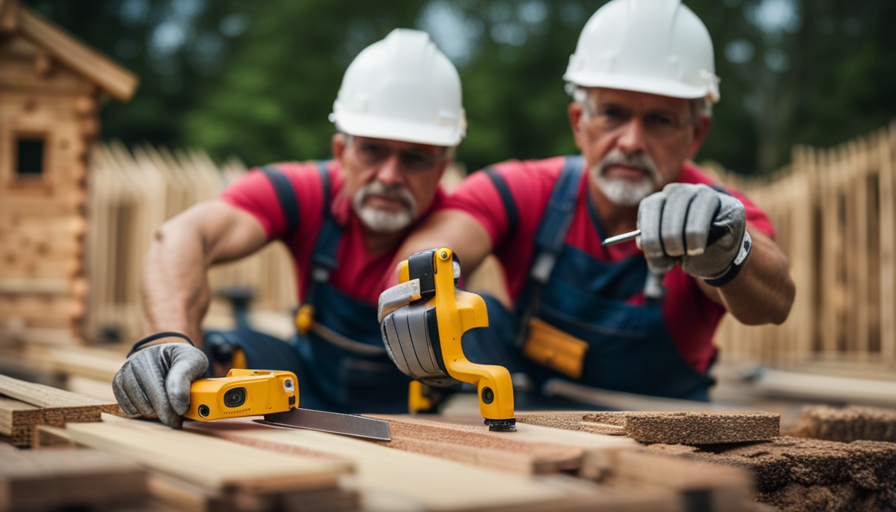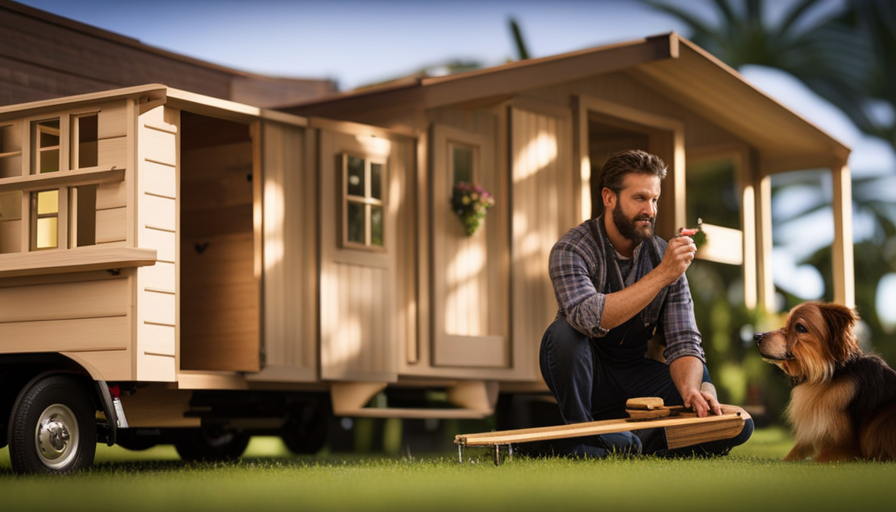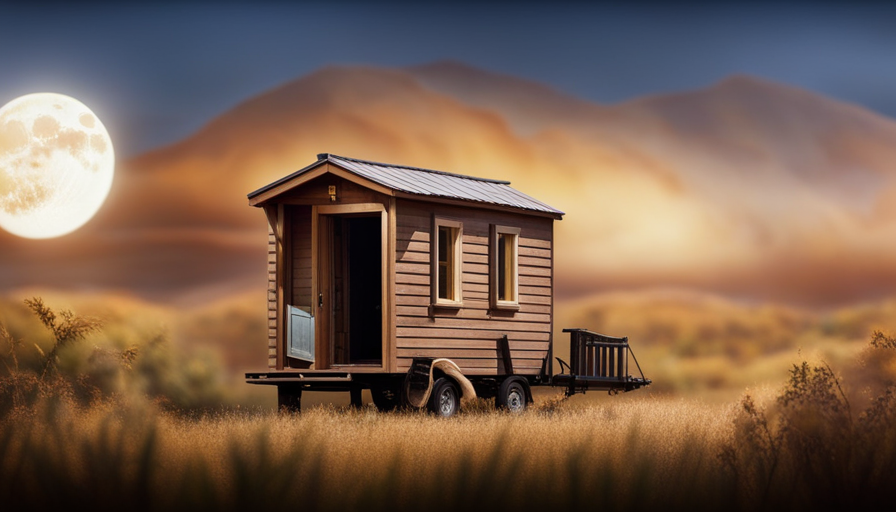Are you considering the idea of embracing the adventurous and liberating lifestyle that comes with living in a tiny house? If so, you may be wondering about the size of the truck needed to tow your mobile home. Although it may seem daunting at first, fear not! I am here to provide you with all the technical, analytical, and informative guidance needed to make this process as simple as can be.
In this article, we’ll explore the weight and dimensions of your tiny house, as well as the towing capacity of different truck models. We’ll also discuss the important considerations for safe and legal hauling, and how consulting with professionals in the tiny house industry can help you navigate this endeavor.
But that’s not all! We’ll also delve into researching and comparing different truck options, and highlight additional equipment and accessories that can enhance your hauling experience. And to top it off, I’ll share some valuable tips for a successful and stress-free journey.
So, buckle up and get ready to embark on this exciting adventure of finding the perfect truck to haul your tiny house!
Key Takeaways
- Proper weight distribution and towing capacity are crucial for safe towing of a tiny house.
- Consult professionals in the tiny house industry for insights on weight limitations and towing capacities.
- Research and compare different truck options, considering towing capacity, engine power, fuel efficiency, and price.
- Ensure proper trailer maintenance and consider additional equipment like weight distribution hitch and trailer lights for enhanced safety.
Weight and Dimensions of Your Tiny House
To haul a tiny house, you’ll need a truck big enough to handle its weight and dimensions, making sure it fits snugly on the flatbed as if it were a perfectly matched puzzle piece.
The first thing to consider is the towing capacity of the truck. This refers to the maximum weight that the truck can safely tow. It is crucial to choose a truck with a towing capacity that exceeds the weight of your tiny house, including all its contents.
Additionally, weight distribution plays a vital role in safe towing. Properly distributing the weight of the tiny house on the truck’s flatbed ensures stability and prevents any issues during transport.
Now that we understand the importance of weight and dimensions, let’s explore the towing capacity of different truck models.
Towing Capacity of Different Truck Models
If you’re considering towing a tiny house, it’s important to know that the towing capacity of various truck models can vary significantly. The weight capacity of the truck is one of the main factors to consider when selecting a suitable model. It is crucial to ensure that the truck you choose can handle the weight of your tiny house, including all the furnishings and belongings inside. Additionally, fuel efficiency is another important consideration, as towing a heavy load can impact the truck’s fuel consumption. To give you an idea of the towing capacities of different truck models, here is a table showcasing some popular options:
| Truck Model | Towing Capacity (lbs) |
|---|---|
| Ford F-150 | 13,200 |
| Chevrolet Silverado 1500 | 13,300 |
| Ram 1500 | 12,750 |
| Toyota Tundra | 10,200 |
Considering these factors will help ensure safe and legal hauling of your tiny house.
Considerations for Safe and Legal Hauling
When it comes to safely and legally hauling a tiny house, there are several key considerations to keep in mind.
First, it’s important to understand the licensing and permit requirements for towing a load of this size.
Additionally, ensuring that your truck has the appropriate trailer hitch requirements is crucial for a secure connection.
Lastly, making sure the trailer has functioning brakes and safety features will help ensure a safe journey.
Licensing and Permits
With the right licensing and permits, you can confidently navigate the road, towing your tiny house behind a sturdy truck. When it comes to licensing requirements, it’s crucial to research the regulations in your specific state or province.
Some jurisdictions may require a special license or endorsement to tow a large load like a tiny house. Permit costs can vary depending on the distance you plan to travel and the size of your tiny house. It’s essential to factor these costs into your budget when planning your move.
Additionally, it’s important to note that permits may have certain restrictions, such as specific travel routes or timeframes. Understanding and adhering to these restrictions will ensure a smooth and legal haul.
Moving forward, it’s crucial to consider the trailer hitch requirements for securely attaching your tiny house to the truck.
Trailer Hitch Requirements
To securely connect your compact abode to the vehicle, it’s important to meet the necessary requirements for your vehicle’s trailer hitch. Proper trailer hitch installation is crucial for a safe and stable towing experience.
When it comes to hauling a tiny house, you’ll need a compatible trailer hitch that can handle the weight and size of your home on wheels. Depending on the weight distribution of your tiny house, you may also need to consider weight distribution systems to ensure a balanced load and prevent strain on your vehicle. These systems help distribute the weight evenly across all axles, improving stability and control while towing.
With the right trailer hitch and weight distribution systems, you can confidently transport your tiny house.
Now, let’s move on to the next section about trailer brakes and safety features.
Trailer Brakes and Safety Features
When considering the trailer hitch requirements for hauling a tiny house, it’s important to also take into account trailer brakes and safety features. These components play a crucial role in ensuring a safe and smooth journey.
Trailer brakes are essential for providing additional stopping power, especially when towing a heavy load like a tiny house. They help prevent the truck from being overwhelmed by the weight and enable it to stop more effectively.
Moreover, safety features such as breakaway systems and emergency braking assist in mitigating potential accidents or mishaps on the road. It is vital to regularly maintain these components to ensure their optimal performance. This includes inspecting and testing the trailer brakes, checking the breakaway system, and keeping emergency braking mechanisms in good condition.
By prioritizing trailer maintenance, you can enhance safety and peace of mind during your tiny house hauling adventures. Now, let’s delve into the importance of consulting with professionals in the tiny house industry to make informed decisions and ensure a successful journey.
Consulting with Professionals in the Tiny House Industry
Consulting professionals in the tiny house industry will give you invaluable insights and guidance, ensuring that you make the right decisions for your dream home. These experts have extensive knowledge and experience in building and transporting tiny houses, and can provide you with valuable advice on the specific requirements and considerations for hauling your tiny house.
They can help you understand the weight limitations, towing capacities, and safety features that your truck should have in order to transport your tiny house safely and efficiently. Additionally, they can offer recommendations on reputable truck brands and models that are commonly used in the industry.
Armed with this information, you can confidently proceed with researching and comparing different truck options that meet the specific needs of your tiny house project.
Researching and Comparing Different Truck Options
Considering the various options available, it’s important to research and compare different trucks to find the perfect fit for your dream home on wheels.
When researching options, it’s essential to look at the truck’s towing capacity, engine power, and fuel efficiency. These factors will determine how well the truck can handle the weight of your tiny house and the distance it can travel without needing frequent refueling.
Comparing prices is also crucial to ensure you get the best value for your money. Look for trucks that offer a balance between performance and affordability.
Once you’ve found the right truck, you can start thinking about additional equipment and accessories for hauling, such as trailer hitches and towing mirrors, to enhance the safety and convenience of transporting your tiny house.
Additional Equipment and Accessories for Hauling
When it comes to hauling a tiny house, there are several additional equipment and accessories that are crucial to consider.
First and foremost, a Weight Distribution Hitch is essential for maintaining proper weight distribution and stability while towing.
Trailer Lights and Wiring are also important to ensure visibility and safety on the road.
Lastly, don’t forget about the Trailer Tires and Suspension, as they play a significant role in providing a smooth and stable ride.
Weight Distribution Hitch
If you want to ensure a smooth and stable journey with your tiny house, hitching it up to a weight distribution system is key. This system helps to evenly distribute the weight of your tiny house across the axles of your truck, improving towing capacity and reducing the strain on both your vehicle and the trailer.
Here are three important things to know about weight distribution hitches:
-
Weight distribution: These hitches work by transferring some of the weight from the rear axle of your truck to the front axle and the trailer’s axles. This helps to maintain proper balance and stability while towing your tiny house.
-
Towing capacity: A weight distribution hitch can increase your towing capacity by reducing the tongue weight on your truck’s rear axle. This allows you to safely tow a heavier tiny house without exceeding the limits of your vehicle.
-
Sway control: Many weight distribution hitches also come with built-in sway control mechanisms. These help to minimize trailer sway caused by crosswinds or passing vehicles, making your journey safer and more comfortable.
When it comes to towing a tiny house, weight distribution hitches are a crucial piece of equipment. Once you have this system in place, the next step is to ensure your trailer lights and wiring are properly connected.
Trailer Lights and Wiring
Now that we’ve discussed the importance of a weight distribution hitch, let’s move on to another crucial aspect of hauling a tiny house – trailer lights and wiring.
Proper maintenance of these components is essential to ensure the safety and functionality of your trailer. Trailer lights not only help you see in the dark, but they also alert other drivers to your presence on the road. Troubleshooting trailer wiring issues can be a bit tricky, but it’s necessary to prevent accidents and ensure compliance with road regulations.
By inspecting and repairing any damaged wiring, connectors, or bulbs, you can avoid potential problems during your journey.
In the next section, we’ll delve into the topic of trailer tires and suspension, which are vital for a smooth and stable ride.
Trailer Tires and Suspension
To ensure a smooth and stable ride while towing, it’s important to have properly inflated tires and a suspension system that can handle the weight of your trailer, keeping it balanced and controlled on the road. Trailer tire maintenance is crucial for safe hauling. Regularly check the tire pressure and tread depth to ensure optimal performance. Uneven tire wear can indicate suspension issues, so it’s essential to address any problems promptly. Upgrading your suspension can greatly improve your hauling experience. Consider options like heavy-duty shocks, leaf springs, or airbags to enhance stability and control. Here is a table to illustrate the importance of tire maintenance and suspension upgrades:
| Tire Maintenance | Suspension Upgrades |
|---|---|
| Proper inflation and tread depth | Heavy-duty shocks |
| Regular inspections for wear | Leaf springs |
| Addressing issues promptly | Airbags |
By taking these measures, you can enjoy a stress-free and successful hauling experience.
Tips for a Successful and Stress-Free Hauling Experience
For a stress-free hauling experience, it’s essential to choose a truck that can effortlessly transport your tiny house without any size constraints. To ensure a successful journey, consider the following tips:
-
Install a weight distribution hitch to evenly distribute the weight of your tiny house across the axles. This will improve stability and control while towing, preventing swaying or fishtailing.
-
Ensure that all the trailer lights are working properly before hitting the road. Check the brake lights, turn signals, and tail lights to ensure visibility and safety.
-
Use strong and reliable tie-downs to secure your tiny house to the truck bed or trailer. Double-check that everything is tightly fastened, reducing the risk of shifting or damage during transport.
By following these tips, you can have a successful and stress-free hauling experience, knowing that your tiny house is securely attached to your truck and that all safety precautions have been taken.
Frequently Asked Questions
What are some common challenges and obstacles that people face when hauling a tiny house with a truck?
When hauling a tiny house with a truck, common challenges arise due to the weight capacity. It’s interesting to note that the average weight of a tiny house is around 10,000 pounds. This poses a significant challenge as many trucks have a lower weight capacity.
Therefore, it’s crucial to ensure that the truck being used has the appropriate weight capacity to handle the load. Failing to do so can lead to safety hazards and potential damage to both the tiny house and the truck.
Are there any specific regulations or permits required for hauling a tiny house with a truck?
Specific regulations and necessary permits are required when hauling a tiny house with a truck. These regulations vary depending on the jurisdiction and the size of the tiny house. It’s important to research and understand the local laws regarding transportation of oversized loads.
Permits may be needed for wide loads, high loads, or loads exceeding specific weight limits. Failure to comply with these regulations can result in fines or even legal consequences.
How do you determine the towing capacity of a truck and match it with the weight of your tiny house?
Determining the towing capacity of a truck and matching it with the weight of your tiny house requires careful consideration.
One interesting statistic is that the average towing capacity of a full-size truck in the US is around 12,000 pounds.
To determine your truck’s specific towing capacity, consult the owner’s manual or contact the manufacturer.
Next, weigh your tiny house to ensure it falls within the truck’s towing capacity.
This weight matching process is crucial for safe and efficient towing.
What are some important factors to consider when choosing a truck for hauling a tiny house?
When choosing the right truck for hauling a tiny house, several factors need consideration. Firstly, the towing capacity of the truck is crucial, as it should be able to handle the weight of the tiny house.
Additionally, the truck’s engine power, transmission, and suspension should be suitable for towing. Other factors include the truck’s wheelbase, axle ratio, and braking system, which all contribute to its towing capabilities.
It’s essential to carefully analyze these factors before making a decision.
Are there any specific safety precautions or best practices to follow when hauling a tiny house with a truck?
When hauling a tiny house with a truck, it’s crucial to follow specific safety precautions and best practices.
Firstly, ensure that the tiny house is securely attached to the truck using proper tie-downs and straps.
Regularly inspect the hitch, brakes, and tires for any signs of wear or damage.
Additionally, be mindful of the weight distribution to maintain stability.
Challenges and obstacles may include navigating narrow roads, low bridges, and sharp turns.
Being cautious and prepared is key to a safe and successful haul.
Conclusion
In conclusion, finding the right truck to haul your tiny house is crucial for a successful and stress-free experience. By considering the weight and dimensions of your tiny house, as well as the towing capacity of different truck models, you can ensure a safe and legal haul.
Consulting with professionals in the tiny house industry and researching and comparing different truck options will also help you make an informed decision. Don’t forget to invest in additional equipment and accessories for a smoother journey.
So, whether you’re embarking on a cross-country adventure or simply moving to a new location, make sure you have the right truck by your side.
Hi, I’m Emma. I’m the Editor in Chief of Tiny House 43, a blog all about tiny houses. While tree houses are often associated with childhood, they can be the perfect adult retreat. They offer a cozy space to relax and unwind, surrounded by nature. And since they’re typically built on stilts or raised platforms, they offer stunning views that traditional homes simply can’t match. If you’re looking for a unique and romantic getaway, a tree house tiny house might just be the perfect option.










